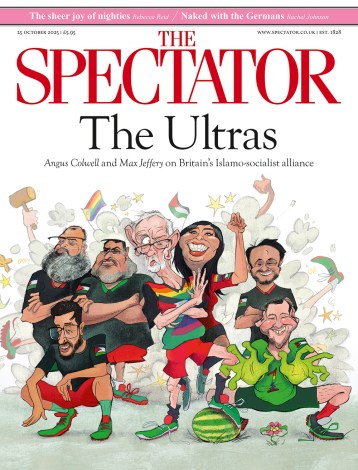If ever I was passing the Courtauld Institute in London with five minutes to spare, I’d chuck the woman behind the desk a fiver, jog up the 300-year-old spiral staircase and go and look at a picture by Wassily Kandinsky called ‘Rapallo: Grey Day’. I know nothing about painting and I knew nothing about Kandinsky except what it said on the wall: that he was Russian and that he travelled around Europe at the turn of the last century with a female artist called Münter. If I thought anything at all, I thought that perhaps Mr Courtauld had unwisely subscribed to someone else’s enthusiasm for a passing fad, but they’d kept it on display because it was so pretty.
Knowledge or no knowledge, however, looking at this picture always did the trick. No other picture has had anything like the same effect. It made me glad to be alive and thrilled by my own prospects. I can’t explain it. Something to do with a similar feeling — sexual, probably — that used to come over me when I was adolescent and looked at nature. Whatever the cause, to run upstairs and be moved without fail by this little picture was well worth a fiver.
I’d never heard of Kandinsky. Nor had I heard the name pronounced. When I thought about ‘Rapallo: Grey Day’, more often than not his name escaped me and I was left with just an authorless image, which was somehow more fitting. And then one day my friend Sharon surprised me by telling me, out of the blue, that the man she’d spent the night with, and was hoping to spend the night with again, liked Kandinsky. Who was this Kandinsky? Had I heard any of his albums?
I’d been introduced to Sharon’s bloke. Not nice. I’d say he was Sharon’s penchant for what she calls a ‘bad boy’ taken to a dangerous extreme. You could characterise him without fear of contradiction as a violent criminal. If art meant anything at all to him, it was as a synonym for deception. The first thing he told me about himself was that he was frightened he was going to kill someone.
And yet once I’d got over the shock of sharing Kandinsky, I was pleased it was with a violent criminal. The Russian word for crime, prestuplenie, literally means ‘stepping across’. Perhaps Kandinsky’s art was accessible only to transgressors of one kind or another.
And then last week I read in a Sunday newspaper a review of an exhibition of Kandinsky paintings at Tate Modern called The Path to Abstraction. A whole exhibition! Kandinsky, I learnt to my great surprise, was one of the most significant artists of the early 20th century — though signifying what, the reviewer unfortunately didn’t say. The early landscapes gave way in later years to purely abstract painting, he said, of which Kandinsky was an early pioneer. Overall, the reviewer confessed himself baffled by Kandinsky’s abstract pictures, though he was big enough to admit that maybe he’d simply had an off day. In another review appearing that day, the reviewer said that she couldn’t understand them either.
I went along last Saturday morning. The place was packed. At the Courtauld you see so few people that when you do see someone else you are glad of the company and say hello. At Tate Modern, there were so many people in front of each picture, it was like rubber-necking at the scene of a series of accidents. Hundreds of sweaty, puzzled, disappointed people with rucksacks were jockeying and craning for a better view, while not one but three babies screamed defiance. It must be at places like Tate Modern on a Saturday morning that those who’ve smartly stepped up a class in the last ten years first realise to their horror that they’ve yet to rise above the masses. Only the Japanese seemed entirely comfortable looking at art in such adverse conditions.
I was so put off by the crowd, the noise and the smell of sweaty armpits that I didn’t bother looking at the pictures. Instead, I stared out of the window at the Millennium Bridge with St Paul’s beyond while my friend conscientiously battled her way round. Most of the paintings were his abstract stuff, in any case. What I could see of it over the heads was how I felt: foolish. Elsewhere people were furiously scrutinising their flimsy brochures for clues that might unravel enough of the puzzle that is Kandinsky to justify the £10 entrance fee. Even though I didn’t look at any of the pictures, I think that overall I much preferred Kandinsky before he was famous.






Comments